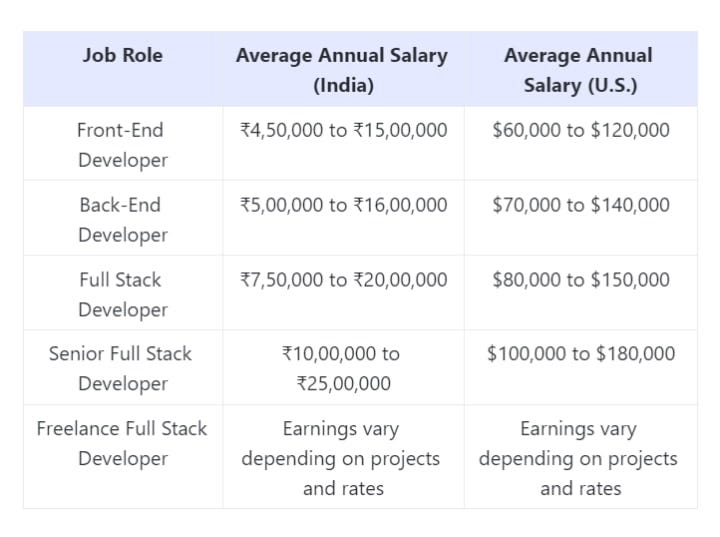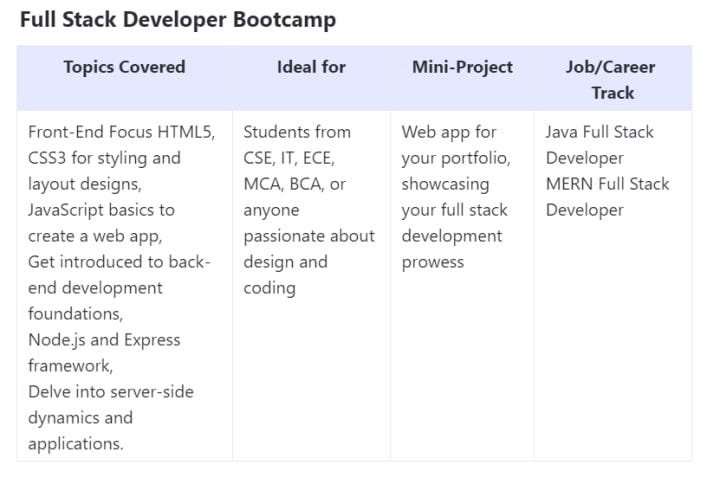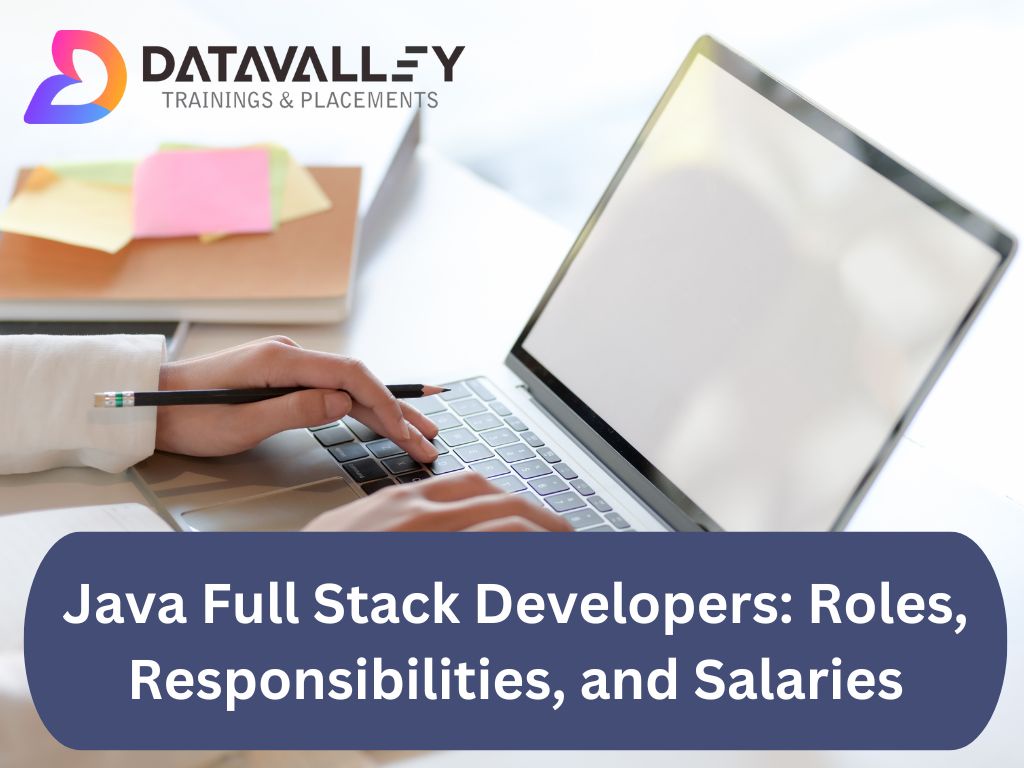A Java full-stack developer is usually a web developer who works primarily with Java programming language. These developers write code for all three layers of the web: frontend, backend, and database. Full-stack java engineers lead web development teams and assist them in designing new websites and updating current ones. Java full-stack developer jobs are in high demand. In this blog, we’ll explore deep into the world of Java Full Stack Developers. We’ll investigate their job roles, responsibilities, and salary in today’s tech-driven job market.
Who is a Java Full Stack Developer?
A Java Full Stack Developer is a multifaceted professional responsible for the end-to-end development of web applications. They are proficient in both front-end and back-end technologies and can work with a variety of tools and frameworks. Full Stack Developers have a solid grasp of Java, a versatile and widely used programming language known for its portability and scalability.
These developers are skilled in converting client and user requirements into usable web apps. They work on the user interface, ensuring that web applications are visually appealing, responsive, and user-friendly. They also take care of the server-side development, managing databases, application logic, and server optimization. In essence, Java Full Stack Developers bridge the gap between design and functionality, making web applications come to life.
Roles of a Java Full Stack Developer
A Java full-stack developer is a single contributor who does the work that involves multiple professionals. They create websites and applications and work with clients to gather requirements. A Java full-stack developer’s primary roles and responsibilities are to:
Front-End Development
It involves designing and building the user interface, as well as ensuring the responsive and engaging user experience. Frontend developers work on the presentation layer of web projects, using various technologies to create a visually appealing and functional interface.
User Interface (UI) Design: Full Stack Developers design and implement user-friendly interfaces, ensuring an optimal user experience.
Client-Side Scripting: They use JavaScript and front-end frameworks like React or Angular to build interactive web pages.
Cross-Browser Compatibility: Ensuring that the web application functions correctly across various browsers and devices.
Back-End Development
In backend development, developers work with databases, servers, and application logic to ensure that the front-end, the part of a website or application that users see and interact with, functions smoothly.
Server-Side Logic: Developing server-side applications using Java-based frameworks like Spring or Java EE.
Database Management: Designing and managing databases, ensuring data security and efficient retrieval.
API Development: Building robust APIs that connect front-end and back-end components.
Application Architecture
Architectural design and application security are crucial in software development. Architectural design involves creating and maintaining an application’s structure and component interactions to ensure optimal performance, scalability, and adaptability to changing demand. At the same time, application security is essential to protect data and applications from potential threats, achieved through measures like encryption, authentication, authorization, and input validation. These security measures mitigate the risk of data breaches and security incidents, ensuring the integrity of the application.
Version Control
Git is the most widely used distributed version control system. It’s known for its speed, flexibility, and robust branching and merging capabilities. Collaborating with teams and managing source code using Git for version control comes under developers responsibility.
Problem Solving and Troubleshooting
Debugging: Identifying and resolving issues within the application.
Optimization: Enhancing application performance and minimizing load times.
Project Management
Coordination: Collaborating with designers, developers, and other team members to ensure project milestones are met.
Timelines: Adhering to project timelines and meeting client expectations.
Average Salary of Java Full Stack Developers
Java Full Stack Developers are in high demand in the employment market, and their salaries reflect this. The salaries may vary depending on factors such as experience, location, and the specific company they work for.
The average annual salary for Java Full Stack Developers in India is approximately ₹7,50,149. However, salaries in India can range from ₹375,000 for beginners to around ₹12–14 lakhs for mid-level professionals with 5–9 years of experience.
In the United States, Java Full Stack Developers earn an average annual salary of $100,026. This figure can vary significantly based on their experience, location within the country, and local job market conditions.
Salary Based on Experience
Salaries for Java Full Stack Developers are often determined by their level of experience. Here’s a breakdown of salary ranges based on experience:
Entry-Level (0–2 years): Entry-level Full Stack Developers can expect to earn salaries starting at ₹375,000 to ₹6,00,000 in India or around $60,000 to $80,000 in the United States.
Mid-Level (3–5 years): With 3–5 years of experience, Full Stack Developers see a significant salary boost. In India, mid-level professionals can earn ₹8–10 lakhs, while in the U.S., salaries range from $85,000 to $100,000.
Senior-Level (6+ years): Senior Java Full Stack Developers, with 6 or more years of experience, command higher salaries. In India, they can earn upwards of ₹15 lakhs, while in the U.S., senior professionals may earn over $120,000.
Top Companies Hiring Java Full Stack Developers
Many prominent tech companies and startups are continually seeking Java Full Stack Developers to drive their web development projects. Here are some top companies known for hiring Full Stack talent:
Amazon: The e-commerce and cloud computing giant offers exciting opportunities for Java Full Stack Developers in various teams, including Amazon Web Services (AWS) and Amazon Prime.
Google: As one of the tech industry’s giants, Google frequently recruits Full Stack Developers for its wide range of web applications, including Google Workspace and Cloud products.
Microsoft: This software and cloud computing powerhouse relies on Full Stack Developers to work on platforms such as Azure and Office 365.
Facebook: The social media giant utilizes Java Full Stack Developers to enhance user experiences and develop various applications, including those for virtual reality.
Netflix: With its global streaming platform, Netflix seeks Full Stack Developers to ensure a seamless user experience and maintain a high-quality video streaming service.
LinkedIn: As a professional networking site, LinkedIn often hires Full Stack Developers to work on its user-friendly interface and innovative features.
Uber: The ride-sharing company relies on Full Stack Developers to maintain the efficiency and functionality of its app, ensuring a smooth experience for riders and drivers.
Spotify: The popular music streaming service frequently recruits Full Stack Developers to improve user interfaces and deliver high-quality music experiences.
Adobe: Known for its creative software, Adobe hires Full Stack Developers to work on its web applications and services, such as Adobe Creative Cloud.
Oracle: This global software company relies on Java Full Stack Developers to enhance its enterprise solutions, cloud services, and database technologies.
Different Job Roles and Their Salaries
In the world of Full Stack Development, various specialized roles exist, each with its unique set of responsibilities and corresponding salaries:
1. Front-End Developer
Role: Focusing on the user interface, user experience, and client-side scripting.
Salary: Front-End Developers can earn an average annual salary of ₹4,50,000 to ₹15,00,000 in India and around $60,000 to $120,000 in the U.S.
2. Back-End Developer
Role: Concentrating on server-side logic, databases, and APIs.
Salary: Back-End Developers often earn salaries ranging from ₹5,00,000 to ₹16,00,000 in India and approximately $70,000 to $140,000 in the U.S.
3. Full Stack Developer
Role: Managing both front-end and back-end development tasks, ensuring seamless application functionality.
Salary: Full Stack Developers earn competitive salaries, with an average annual pay of ₹7,50,000 to ₹20,00,000 in India and $80,000 to $150,000 in the U.S.
4. Senior Full Stack Developer
Role: Taking on a leadership position, overseeing complex projects, and mentoring junior developers.
Salary: Senior Full Stack Developers command higher salaries, with earnings ranging from ₹10,00,000 to ₹25,00,000 in India and $100,000 to $180,000 in the U.S.
5. Freelance Full Stack Developer
Role: Offering services independently to various clients or projects.
Salary: Freelancers have income variations but can often set their rates, with potential earnings aligning with their skills and the projects they take on.

Java full-stack developers are essential participants in the world of web development. combining front-end skills with back-end proficiency. Their roles are dynamic, their responsibilities multifaceted, and their earning potential is promising. As technology advances, full-stack developers are sure to remain in high demand.
FAQs
1. Is Java still relevant for Full Stack Development?
Yes, Java remains highly relevant for Full Stack Development, thanks to its portability, scalability, and extensive libraries and frameworks.
2. Do I need a formal degree to become a Java Full Stack Developer?
While a formal degree can be beneficial, many Full Stack Developers are self-taught or have completed coding bootcamps. Practical skills and experience often weigh more heavily in hiring decisions.
3. What are the essential skills for a Java Full Stack Developer?
Essential skills include proficiency in Java, front-end technologies like HTML, CSS, JavaScript, back-end frameworks like Spring, database management, and API development.
4. Are Full Stack Developers in demand?
Absolutely. The demand for Full Stack Developers continues to rise as companies seek versatile professionals who can handle all aspects of web development.
5. How can I increase my salary as a Full Stack Developer?
Continuous learning, acquiring new skills, and gaining experience can help you move up the salary ladder. Specializing in niche technologies can also boost your earning potential.
Attend Free Bootcamps by Datavalley
If you’re considering a career in this field, don’t hesitate to dive into the world of Java full-stack development. Your journey may start with a bootcamp at Datavalley, a place where you can acquire the skills to thrive in this exciting industry. So, why wait? Join our bootcamp and start your journey to becoming a successful Java full-stack developer.
Key points about Bootcamps:
- It is completely free, and there is no obligation to complete the entire course.
- 20 hours total, two hours daily for two weeks.
- Gain hands-on experience with tools and projects.
- Explore and decide if the field or career is right for you.
- Complete a mini-project.
- Earn a certificate to show on your profile.
- No commitment is required after bootcamp.
Take another bootcamp if you are unsure about your track.



No comments yet